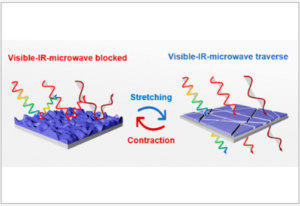A seemingly magical material can block microwaves, infrared (IR) heat, and light and then magically shift to a transparent state that also allows IR and microwaves to pass through simply by being stretched or contracted.
Inspired by the properties of squid skin, which can shift from translucent to opaque due to the presence of iridocytes and chromatophores, the new material could help create stealth materials, safeguard electronic devices, dramatically improve energy efficiency in commercial buildings, and even protect against microwave weapons.
No One Has Accomplished All of These Feats in One Material
In the last few decades, researchers have developed a number of different seemingly magical materials. Some can shift from transparent or translucent states to more opaque states, with common applications including use in external office windows to improve energy usage or for internal windows that shift between public (transparent) and private (opaque) modes.
This ability was first noted in cephalopods like squids, which can shift the iridocytes and chromatophores embedded in their skin cells to alter their appearance, just one of the unique traits about these animals that have had some biologists asking if they are actually alien creatures.
Similarly, materials have been developed that can block electromagnetic (EM) emissions, like microwaves. The Debrief previously reported on one such metamaterial called MXene, which was developed by researchers at Drexel University with a number of practical applications in mind.
“We have discovered that MXene shielding can absorb and reflect electromagnetic waves,” Dr. Yury Gogotsi, the head of the research team, told The Debrief at the time, “so it not only protects the wearable devices and electronic gadgets but also protects people from strong electromagnetic field[s].”
Now, A team of Chinese researchers says they have combined the benefits of these cutting-edge materials into one super material that can be commanded to block light, IR, microwaves, and other EM emissions or let them through.
Silver Nanowires Are The Key Ingredient For Blocking microwaves and other em Waves
“[We] wanted to integrate surface structures with a conductive network in a soft film that could quickly transition between shielding visible-to-microwave bands and allowing them through,” explained researchers Yi Yang, Guangbin Ji, Zhichuan J. Xu and their colleagues in the press release announcing their research.
To develop their magic material that contained all of these amazing properties, the team first looked at current methods in use to imbue these particular properties into a substrate of glass and other materials. They quickly determined that windows that can shift between transparent and opaque states typically embed tiny structures within the glass that wrinkle under an electric current. Separately, materials that successfully block EM and IR emissions often employ microscopic silver nanowires embedded into a base material.
With this knowledge in hand, the team created a two-layer film by spraying a thin layer of silver nanowires onto a stretched elastomer. Next, they stretched and contracted the material thoroughly to create tiny cracks and wrinkles on the material’s surface.


After some trial and error, the researchers found what they were hoping for. When their new material was contracted to a -30% strain, “it blocked light, trapped infrared heat and shielded up to 99.9% of microwaves.”
Then the team stretched the material back out and found that “the expansion was directly related to an increase in optical transparency and heat and microwaves it transmitted.”
Wide Range of Potential Applications for Magical Material
Published in ACS Nano, which is the journal of the American Chemical Society, the team says there are a number of potential applications for their new material. Some of those include:
- Transmitting or blocking wireless electrocardiography signals.
- As a blanket to trap body heat or allow it to escape.
- For tracking movements because the materials produce temperature changes that are detectable by infrared cameras.
The team also notes that their system’s ability to modify its transparency repeatedly and rapidly “could benefit dynamic camouflage technologies, energy-efficient buildings, and adaptive personal and healthcare devices.”
Along with these listed applications, such material could theoretically be used to safeguard people against weapons using microwaves that are increasingly under development by militaries around the world and which some theorize could be behind the so-called “Havanna Syndrome” attacks that have often plagued American diplomats serving overseas.
But no matter how this magical material is ultimately used, its original inspiration may be one more reason to think that squids and octopuses are out of this world.
Christopher Plain is a Science Fiction and Fantasy novelist and Head Science Writer at The Debrief. Follow and connect with him on Twitter, learn about his books at plainfiction.com, or email him directly at christopher@thedebrief.org.

